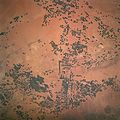File:Saudi Arabia irrigation.jpg
Appearance

Size of this preview: 600 × 599 pixels. Other resolutions: 240 × 240 pixels | 480 × 480 pixels | 769 × 768 pixels | 1,025 × 1,024 pixels | 2,050 × 2,048 pixels | 4,000 × 3,996 pixels.
Original file (4,000 × 3,996 pixels, file size: 12.64 MB, MIME type: image/jpeg)
File history
Click on a date/time to view the file as it appeared at that time.
| Date/Time | Thumbnail | Dimensions | User | Comment | |
|---|---|---|---|---|---|
| current | 09:17, 21 August 2012 |  | 4,000 × 3,996 (12.64 MB) | Bulwersator | larger, from source |
| 09:14, 21 August 2012 |  | 639 × 639 (151 KB) | Bulwersator | Transferred from en.wikipedia: see original upload log above |
File usage
The following 3 pages use this file:
Global file usage
The following other wikis use this file:
- Usage on ar.wikipedia.org
- Usage on zh.wikipedia.org
